
Buckwheat, or common buckwheat, is a plant cultivated for its grain-like seeds and as a cover crop. The name "buckwheat" is used for several other species, such as Fagopyrum tataricum, a domesticated food plant raised in Asia. Despite the name, buckwheat is not closely related to wheat, as it is not a grass. Instead, buckwheat is related to sorrel, knotweed, and rhubarb. Buckwheat is referred to as a pseudocereal because its seeds' culinary use is the same as cereals', owing to their composition of complex carbohydrates.

Eriogonum nudum is a perennial shrub of the wild buckwheat genus which is known by the common name naked buckwheat or nude buckwheat.

Chorizanthe brevicornu is a species of flowering plant in the buckwheat family which is known by the common name brittle spineflower. It is native to the southwestern United States and northern Mexico, where it is widely distributed but is most abundant in the deserts.

Descurainia pinnata is a species of flowering plant in the family Brassicaceae known by the common name western tansymustard. It is native to North America, where it is widespread and found in varied habitats. It is especially successful in deserts. It is a hardy plant which easily becomes weedy, and can spring up in disturbed, barren sites with bad soil. This is a hairy, heavily branched, mustardlike annual which is quite variable in appearance. There are several subspecies which vary from each other and individuals within a subspecies may look different depending on the climate they endure. This may be a clumping thicket or a tall, erect mustard. It generally does not exceed 70 centimeters in height. It has highly lobed or divided leaves with pointed, toothed lobes or leaflets. At the tips of the stem branches are tiny yellow flowers. The fruit is a silique one half to two centimeters long upon a threadlike pedicel. This plant reproduces only from seed. This tansymustard is toxic to grazing animals in large quantities due to nitrates and thiocyanates; however, it is nutritious in smaller amounts. The flowers are attractive to butterflies. The seeds are said to taste somewhat like black mustard and were utilized as food by Native American peoples such as the Navajo.
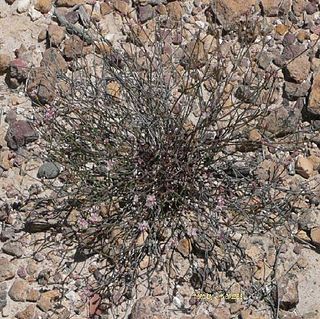
Eriogonum apricum is a rare species of wild buckwheat known by the common name Ione buckwheat. It is endemic to Amador County, California, in the United States.
Eriogonum dasyanthemum is a species of wild buckwheat known by the common name chaparral buckwheat. This plant is endemic to California where it is limited to the Northern Coast Ranges, but it is quite common in its native range.

Eriogonum elatum is a species of wild buckwheat known by the common name tall woolly buckwheat. It is native to the western United States from California to Idaho. It is a perennial herb varying in size from one half to 1.5 meters in height. Its long leaves are located at the base of the plant and can be quite long for a buckwheat, over 20 centimeters in maximum length. The erect, branching stems are thin and naked and occasionally hollow. The plant produces small to large inflorescences with clusters of tiny flowers in shades of white to dark pink.
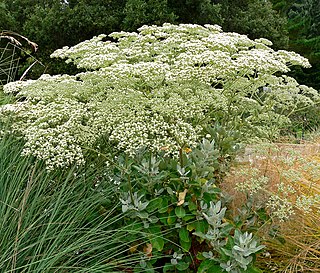
Eriogonum giganteum, with the common name St. Catherine's lace, is a species of wild buckwheat in Southern California.
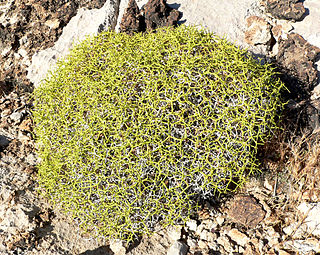
Eriogonum heermannii is a species of wild buckwheat known by the common name Heermann's buckwheat. It is native to the southwestern United States from California to Utah where it grows on rocky slopes, desert flats, and dry washes.
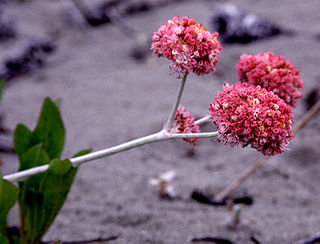
Eriogonum latifolium is a species of wild buckwheat known by the common names seaside buckwheat and coast buckwheat. This plant is native to the coastline of the western United States from Washington to central California, where it is a common resident of coastal bluffs and scrub.

Eriogonum maculatum is a species of wild buckwheat known by the common name spotted buckwheat. It is native to western North America from Washington to Baja California to Utah, where it can be found in a number of habitats, often in abundance.

Eriogonum microthecum is a species of wild buckwheat known by the common name slender buckwheat. It is native to the western United States where it is found in a variety of habitats, particularly in dry areas such as deserts.

Eriogonum nidularium is a species of wild buckwheat known by the common name birdnest buckwheat. It is native to the sandy flats and desert dry washes of the Mojave Desert and Great Basin in the western United States, where it is common and abundant. This is a distinctive annual herb producing a thin, multibranched stem which curves in on itself to form a rounded, tangled mass.
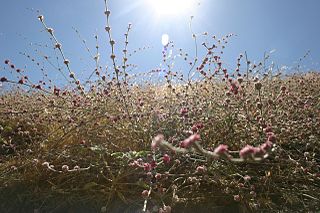
Eriogonum roseum is a species of wild buckwheat known by the common name wand buckwheat. It is native to much of western California and the Sierra Nevada foothills, as well as parts of Oregon, and it is widespread and common in several plant communities.

Eriogonum wrightii is a species of wild buckwheat known by the common names bastardsage and Wright's buckwheat. It is native to the Southwestern United States, California, and northwest Mexico, where it grows in many plant communities, such as chaparral, in rocky habitats from mountains to deserts.

Eriogonum brachyanthum is a species of wild buckwheat known by the common name shortflower buckwheat. It is native to eastern California and western Nevada, particularly the Mojave Desert region, where it is common to abundant, and even sometimes weedy. It is also known from southern Oregon. The plant grows in sandy habitat, such as desert flats and sagebrush. It is an annual herb reaching 30 to 40 centimeters tall. The woolly leaves are oval or rounded and are located about the base of the stem. The top of the stem is occupied by a branching inflorescence bearing many widely spaced clusters of flowers. Each individual flower is about a millimeter wide and light yellow in color.
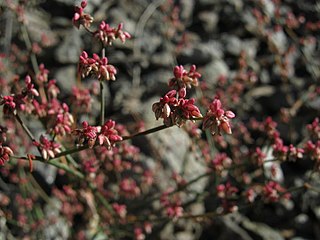
Eriogonum hoffmannii is a species of wild buckwheat known by the common name Hoffmann's buckwheat. It is endemic to Inyo County, California, where it is found only in the mountains around Death Valley; most of the known populations of the plant are located in Death Valley National Park. The plant grows in the desert scrub on the slopes of the Panamint, Black, and Funeral Mountains.
Eriogonum pendulum is a rare species of wild buckwheat known by the common name Waldo buckwheat. It is endemic to the Klamath Mountains of Josephine County, Oregon, and Del Norte County, California, where it is a member of the serpentine soils flora.
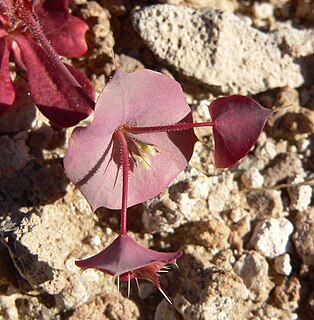
Oxytheca perfoliata is a species of flowering plant in the buckwheat family known by the common names round-leaf puncturebract and roundleaf oxytheca. It is native to the southwestern United States, where it is a common plant of the deserts and some woodland and valley areas. It is an annual herb producing a leafless stem up to about 20 centimeters in maximum height in the spring; during the winter the plant is a small rosette of oblong or spoon-shaped leaves a few centimeters wide. The plant is red-veined green, or often brown to maroon or magenta in color. The inflorescence atop the stem is punctuated by nodes at which the bracts are fused to form a cup or band up to about 2.5 centimeters wide. At the end of each branching of the stem is a similar cup of bracts partially fused around a cluster of flowers. The bracts are tipped in spinelike awns. The flowers are white to yellow-green and hairy in texture.

Eriogonum niveum is a species of flowering plant in the buckwheat family known by the common name snow buckwheat. It is native to the Pacific Northwest of North America, where it occurs in British Columbia, Washington, Oregon, and Idaho.


















